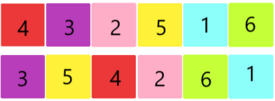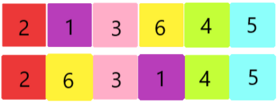| Codeforces Round 789 (Div. 1) |
|---|
| Finished |
Tokitsukaze has two colorful tapes. There are $$$n$$$ distinct colors, numbered $$$1$$$ through $$$n$$$, and each color appears exactly once on each of the two tapes. Denote the color of the $$$i$$$-th position of the first tape as $$$ca_i$$$, and the color of the $$$i$$$-th position of the second tape as $$$cb_i$$$.
Now Tokitsukaze wants to select each color an integer value from $$$1$$$ to $$$n$$$, distinct for all the colors. After that she will put down the color values in each colored position on the tapes. Denote the number of the $$$i$$$-th position of the first tape as $$$numa_i$$$, and the number of the $$$i$$$-th position of the second tape as $$$numb_i$$$.

For example, for the above picture, assuming that the color red has value $$$x$$$ ($$$1 \leq x \leq n$$$), it appears at the $$$1$$$-st position of the first tape and the $$$3$$$-rd position of the second tape, so $$$numa_1=numb_3=x$$$.
Note that each color $$$i$$$ from $$$1$$$ to $$$n$$$ should have a distinct value, and the same color which appears in both tapes has the same value.
After labeling each color, the beauty of the two tapes is calculated as $$$$$$\sum_{i=1}^{n}|numa_i-numb_i|.$$$$$$
Please help Tokitsukaze to find the highest possible beauty.
The first contains a single positive integer $$$t$$$ ($$$1 \leq t \leq 10^4$$$) — the number of test cases.
For each test case, the first line contains a single integer $$$n$$$ ($$$1\leq n \leq 10^5$$$) — the number of colors.
The second line contains $$$n$$$ integers $$$ca_1, ca_2, \ldots, ca_n$$$ ($$$1 \leq ca_i \leq n$$$) — the color of each position of the first tape. It is guaranteed that $$$ca$$$ is a permutation.
The third line contains $$$n$$$ integers $$$cb_1, cb_2, \ldots, cb_n$$$ ($$$1 \leq cb_i \leq n$$$) — the color of each position of the second tape. It is guaranteed that $$$cb$$$ is a permutation.
It is guaranteed that the sum of $$$n$$$ over all test cases does not exceed $$$2 \cdot 10^{5}$$$.
For each test case, print a single integer — the highest possible beauty.
361 5 4 3 2 65 3 1 4 6 263 5 4 6 2 13 6 4 5 2 1111
18 10 0
An optimal solution for the first test case is shown in the following figure:

The beauty is $$$\left|4-3 \right|+\left|3-5 \right|+\left|2-4 \right|+\left|5-2 \right|+\left|1-6 \right|+\left|6-1 \right|=18$$$.
An optimal solution for the second test case is shown in the following figure:

The beauty is $$$\left|2-2 \right|+\left|1-6 \right|+\left|3-3 \right|+\left|6-1 \right|+\left|4-4 \right|+\left|5-5 \right|=10$$$.
| Name |
|---|




